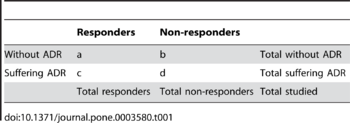Net efficacy adjusted for risk
Jump to navigation
Jump to search
In statistics, net efficacy adjusted for risk (NEAR) is a measure that combines measure of efficacy and risk into a single metric.[1][2] For example, the relative risk of efficacy can be combined with the relative risk for drug toxicity into a single NEAR RR. Alternatively, the odds ratio of efficacy can be combined with the odds ratio for drug toxicity into a single NEAR OR.
Using the second table, let b1+c1+d1 = S1 and b2+c2+d2 = S2. Then
The 95% confidence intervals can be calculated by the method of Boada.[1]
References
- ↑ 1.0 1.1 Boada JN, Boada C, García-Sáiz M, García M, Fernández E, Gómez E (2008). "Net efficacy adjusted for risk (NEAR): a simple procedure for measuring risk:benefit balance.". PLoS One 3 (10): e3580. DOI:10.1371/journal.pone.0003580. PMID 18974868. PMC PMC2570485. Research Blogging.
Cite error: Invalid
<ref>tag; name "pmid18974868" defined multiple times with different content - ↑ Boada J, Boada C, Garcia MM, Rodriguez C, Garcia M, Fernandez E (2009). "Net efficacy adjusted for risk: further developments.". Expert Opin Drug Saf 8 (6): 649-54. DOI:10.1517/14740330903241576. PMID 19708816. Research Blogging.





